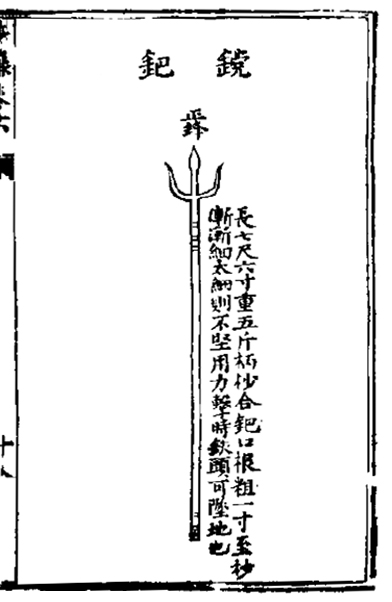 |
| Drawing of a standard military Tang Pa, from 'Bing Lu (《兵錄》)'. |
A Tang Pa (鎲鈀) is a Chinese polearm that is somewhat similar to a European
ranseur. It consists of a spearhead and two crescent-shaped, unsharpened prongs. Unlike ranseur, the spearhead of Tang Pa is only slightly longer than its prongs.
Tang Pa is actually a compound word of
Tang (鎲, trident) and
Pa (鈀, rake), two families of similar polearms, and can be used as a catch-all term to describe all of them. Military Tang Pa used in the Ming army was developed from several types of militia polearm/farm implements during the struggle against
Wokou (倭寇). This versatile weapon later spread to neighbouring countries as well, and was known as
Dangpa (당파 or 鐺鈀) by the Koreans and
Đinh Ba (釘鈀) by the Vietnamese.
While Tang Pa can measure up to eight
chi in length, it was still considered a short weapon by the Chinese. To make up for its shorter reach, Ming troops armed with Tang Pa were often issued
rockets as well. They used the prongs on the Tang Pa as rocket racks to launch rockets.
Variants and predecessors of Tang Pa
Yi Pa (㑥耙)
 |
| Drawing of a Yi Pa, from 'Wu Bei Zhi (《武備志》)'. |
Yi Pa is essentially a straight, wooden or bamboo garden fork with its tines reinforced with iron tips. It is very short for a polearm, only five
chi one
cun in length, and its pines are not very effective in thrusting. However, Yi Pa does make a good parrying weapon.
Pa (扒, rake)
 |
| Two Pa, one wooden and one metal (highlighted), from 'San Cai Tu Hui (《三才圖會》)'. |
Pa is a modified rake frequently used by Chinese villagers in village-to-village conflict. It is a toothed bar fixed horizontally to a handle, similar to agricultural rake it is modified from. However, unlike the agricultural rake which has its tines arranged in a neat row, tines of Pa are installed unevenly over the entire surface of the bar. There are two variations of Pa:
Mu Pa (木扒, wooden rake), a Pa with wooden head and iron tines, and
Tie Pa (鐵扒, iron rake), which has its entire head made out of metal. Incidentally, Pa is almost identical to
tsukubō (つくぼう or 突棒), a Japanese law enforcement weapon.
Qi Ji Guang (戚繼光) greatly disliked the weapon as he considered it completely ineffective against Wokou.
Tang (鎲)
 |
| A Tang (left) and a wooden Pa (right), from 'Wu Bei Zhi (《武備志》)'. |
Tang is the fully militarised form of Pa that comes with proper spear head and metal prongs. It is one of the many variants of military Tang Pa, differentiated from the standard Tang Pa by its toothed prongs.
In modern Chinese martial arts communities, this weapon is known as
Chi Yi Yue Ya Tang (齒翼月牙鎲, lit. 'Tooth-winged crescent Tang').
Mao Lian Tang (茅鐮鎲)
 |
| A Mao Lian Tang (highlighted), from 'Si Zhen San Guan Zhi (《四鎮三關志》)'. |
Mao Lian Tang is a uncommon variant of military Tang Pa with two downward-facing hooks protruding from the prongs.





Wonderful work! I have a few questions. Where in the _Sancai Tuhui_ do these weapons appear? Can you point me to the work in which General Qi says he dislikes them? And do you know of any other Ming works that mention the war rake? I ask because I'm researching a blog on such weapons as they pertain to the literary character Zhu Bajie from _Xiyouji_. Thank you.
ReplyDelete@M
DeleteGood day and welcome to my blog.
The weapons appear in the 《三才圖會.器用》(Sancai Tuhui - items and equipment section)volume eight. Qi Ji Guang's comment on the Pa can be found on the preface of Ji Xiao Xin Shu.
There are several other treatises that mentioned the weapon, although I recall they basically copied from the same source.
As far as I am aware, Bajie's rake is an authentic agriculture rake, not the militarised version.
Thank you for the prompt reply. Based on what I've read here, I agree that it was most likely an agricultural rake.
DeleteWhy do the 鏜s have spikes/appendages backwards?
ReplyDeleteIt's possible that those spikes are actually aligned perpendicularly to the spearhead. They are (probably) throwback to the agricultural origin (i.e. rake) of the weapon.
Delete